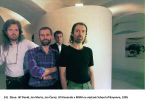Zejména začátkem 90. let minulého století vznikla v rámci „kulturního" a/nebo "ekonomického" sektoru řada osobních i skupinových iniciativ. Většina z nich měla poměrně krátkou životnost, zejména ty, které navazovaly na nebo recyklovaly předchozí ověřené „alternativní“ či „kontrakulturní“ modely a strategie paralelních komunit 60. a 70. let. V jistém smyslu se ten omezený životní cyklus mohl stát pozitivní a obohacující zkušeností.
Flashbacky jsou hlučné, trýznice a bolestivé průniky minulosti. Vznikají z napětí mezi snahou zapomenout a nutkavou potřebou vzpomínat... Linearita vnímání času, přirozeně narušující paměť, je narušena traumatickou událostí, která ruší integraci minulosti do příběhu, ruší asimilaci paměťových systémů. Pod vlivem konfliktu, tělesného přeuspořádání času se opakovaně a vtíravě vrací vzpomínky na minulost jako flashback, tedy jako sluchové, vizuální a senzorické halucinace nebo sny, jednou přesné, intenzivně jasné a živé a doprovázené mnoha smyslovými a emocionálními, jindy rozdrobenými a matnými asociacemi.
Cathy Caruth: Unclaimed Experience: Trauma and the Possibility of History
The key point is that all systems (from the very largest, the universe as a whole, to the very smallest nano-systems), have three moments: their coming into existence, their “normal” life during which they are constructed and constrained by the institutions they have created, and the moment in which their secular trends move too far from equilibrium and bifurcate.
Immanuel Wallerstein
Čím více se moderní společnost jeví být bez alternativy, tím umí být více cynická. Nakonec je vůči své vlastní legitimizaci ironická. Její „základní hodnoty“ a její výmluvy se začnou nenápadně prolínat.
Peter Sloterdijk: Critique of Cynical Reason, translated by Michael Eldred. German edition: Kritik der zynischen Vernunft, University of Minnesota Press, 1987.
Doufám, že k těmto dnes už skoro „historickým“ kulturním a/nebo uměleckým jevům a iniciativám jako byla Nadace Hermit přistupovat v souvislosti – jak akademických tak neakademických – diskusí, které vznikají kolem módních slov jako „kolektivní národní identita“ nebo „politika paměti“. Protože: kdo je vlastně kompetentní aby mohl posuzovat a komentovat naši minulost? Co vlastně podobné "mnemotechnické" tvrzení obnáší? Napadlo mne pokusit se přistoupit k podobným narativům prizmatem "kulturních válek" – tedy kulturních střetů, hluboce propojených se sociálními, politickými, kulturními či ideologickými turbulencemi a s napětím společností ve východní a střední Evropě (i mimo ni).
Přinejmenším během posledních deseti let vnímáme napětí ve veřejné sféře České republiky, Slovenska, Polska či Maďarska například v diskusích, rezonujících v české veřejnosti: shodneme se ohledně naší „totalitní“ minulosti během normalizace mezi lety 1969 a 1989? Co vyvolává turbulence různých „antisystémových“ protestů při demonstracích v ulicích i v parlamentě? A (i kdy v menším měřítku) shodneme na interpretaci událostí, jichž jsme byli během prvních let transformace, návratu politické plurality a tržní ekonomiky po Sametové revoluci součástí? V Polsku se pdobné hádky a diskuse odvíjejí kolem podobných témat, ale jsou zabarveny působením nacionalistů ve vládě a vlivem katolické církve. Podobná rétorika je přítomna v Maďarsku i na Slovensku a do jisté míry i v Chorvatsku, Slovinsku, Srbsku, Rumunsku nebo Bulharsku.
Tyto kontroverze jsou někdy násilné, jindy mírnější konfrontace různých názorů nebo ideologických pozic a živí je nízká míra zdravého rozumu a nejistoty, jak se se sdílenými „malými“ dějinami „vyrovnat“. Nezabýváme se zde spíš naší budoucností než naší minulostí? Záchvěvy podobných "záblesků paměti" nás mohou pronásledovat „palčivými“ otázkami typu: kdo jsem já a kdo jsme my? Jaká je moje skutečná identita? Jak pevná byla moje etická neústupnost jako jednotlivce i jako součásti třídy nebo komunity? Flashbacky nás znepokojují, vyvolávají pocit špatného svědomí, potlačené, nebo dokonce odmítnuté vzpomínky. Činy, na které bychom raději zapomněli.
Potlačené vzpomínky dovedou zabarvit naše způsoby vnímání, vyvolat pozměněné, transu podobné myšlení a porušit smysl pro skutečnost. Pokud si nejsme jisti, jak se s nimi vypořádat, mohou ovládnout naši vůli, zablokují se, takže se stáváme zranitelnějšími a snáze vystaveni emocionálním výkyvům a extrémním politickým vlivům.
Cílem a časovým horizontem neformálního setkání v září v Olomouci byly diskuze jak reflektovat téma okrajových dějin, kultury a udržitelnosti v rámci soukromých uměleckých archivů, které zůstaly z doby mezi lety 1989 a 2000. Výstava Hermit Flashback se stala možnou připadovou studií malého souboru takových „historických“ dokumentů, které zůstaly z konkrétní iniciativy, která téměř naprosti před 25 lety zmizela. Nicméně v paměti učastníků a v podobě fotografické dokumentace její jistá podoba aury přežila, i když to bylo jen „náhodou“. Takový stav zranitelnosti / křehkosti / dočasnosti není výlučný jen pro „transformační období“ 90. let, nebo pro situaci zemí bývalého východního bloku. Předpokládejme, že je symptomatický pro každé období přechodu od starého k novému režimu.
Na setkání na konci výstavy jsme pozvali ty, kteří (jak jsme doufali) mohou nějak komentovat základy současné situace v umění a kultuře střední Evropy. V Olomouci jsme vyslechli osobní zkušenosti a úvahy Gertrudy Moser Wagnerové, Martina Zeta, Tomáše Rullera, Michala Murina, Michaela Delii, Alexandra Roberta Mousta a Davida Millera. Jsou na seznamu asi 400 lidí, kteří se aktivně účastnili akcí Hermitu v 90. letech. Marina Gržinič, Jovita Pristovšek, Miklós Peternák a Dušan Barok, kteří se účastnili online, zmínili širší kontury konkrétní situace jak pro dnešní, tak i tehdejší Maďarsko, Slovensko či Slovinsko. Petr Bergmann vyprávěl o svém úsilí o vybudování „alternativní“ kulturní komunity v Praze a později v odlehlé oblasti východních severních Čech. Byl aktivní víceméně ve stejné době, kdy aktivity nadace Hermit končily. Ivan Mečl jako kulturní/umělecký/aktivistický aktivista, nezávislý vydavatel a spiritus agens se po dobu 30 let dokázal adaptovat měnící se českou společnost a přežil dodnes.
Tvrdím, že individuální „příběh Hermitu“ se zrodil z ducha doby a byl protkán heterogenními, asynchronními texturami s podobnými (starobylými i současnými) narativy, myšlenkami a koncepty, přesahujícími omezení a restrikce jakýchkoli singulárních „snah“ nebo „úspěchů“. Pro příležitost antologie jsem se rozhodl že vyhledám a oslovím i někeré další „aktéry“, kteří psali o 90. letech, nebo v nich byli aktivní: najdete zde rozhovory Dušana Baroka s Dianou McCarty, Jánosem Sugárem, text Martina Škabrahy, Mirka Vodrážky, Erica Kluitenberga, Teda Byfielda a Felixe Stadlera, Roberta Horvitze, Kristófa Nagyho, Magdaleny Moskalewicz, Madiny Tlostanovy, Jánose Varghy, Boba Kuříka a Arnošta Nováka i dalších.
Nebylo by moc zajímavé uvažovato roli umění v postsocialistických společnostech v letech 1989–2000, aniž bychom se pokusili dotknout současné situace v Evropě roku 2024/25. Jak se geopolitické prostředí střední Evropy za posledních 30 let mění a jaké zde vidíme tendence? Nesledujeme cestu mířící směrem k novým fyzickým a virtuálním zábranám,vstávajím z ruin našich selhání v komunikaci a zanedbávání poučení z vlastních dějin? Pokud se pokusíme srovnat situaci České republiky, Slovenska, Maďarska, Polska nebo dokonce Rakouska, zdá se, že oni „kosmopolitní“ liberálové, kteří většinou úspěšně vítězili v prvních letech 90. let v soutěži s komunisty, národními konzervativci a populisty, ustupují, nebo se alespoň mění v kohosi jiného. A naopak ti, kdo byli tehdy poraženi, se vracejí, aby se mohli pomstít. Tito noví populisté často navazují aliance s evropskými i globálními aktéry antiliberálního obratu, s neo-nacionalistickými, neofašistickými nebo neoliberálně konzervativními mocnostmi.
Victor Orbán v roce 2017 trefně prohlásil: „V roce 1989 jsme naši budoucnost viděli v Evropě. Dnes jsme se stali my budoucností Evropy.“ A zní to téměř jako výrok jasnozřivého proroka.
Vlna neonacionalismu / ultrakonzervatismu nebo fašismu ve střední Evropě se zdá vyrůstat z podloží doznívání nedospělých „postkomunistických“ společností nebo je výrazem střetů mezi totalitní minulostí a plně demokratickou budoucností. Ale možná je to nedílná struktura a součást panevropského, možná dokonce globálního „anti-globalistického“ hnutí? Součástí souboje o identitu společnosti jako lidské rasy. Když byly v 90. letech ve střední Evropě zaváděny nástroje tržní ekonomiky a liberální demokracie, křehká rovnováha mezi kosmopolitně-liberálním a národně-konzervativním táborem ztratila svůj raison d’être. Kde dnes hledat brány do „země zaslíbené“ čím nahradit vzdálenou utopii o vítězném globálním Západu? Kde je „skutečné“ společenství kde budou moci být rovně zastoupeny všechny a všichni:Východ-Západ-Jih-Sever?
Ivan Krastev v článku (Rozpad pořádku po roce 1989) vyslovil obavu, že „zavedení neliberálních režimů v Maďarsku a Polsku – doplněné o kontrolu médií, nepřátelství vůči nevládním organizacím, neúctu k nezávislosti soudnictví a intenzivní polarizaci – u mnohých vzbuzuje strach, že střední a východní Evropa kráčí jako náměsíčník zpátky do 30. let 20. století.“
Miloš Vojtěchovský
Praha, listopad 2024






